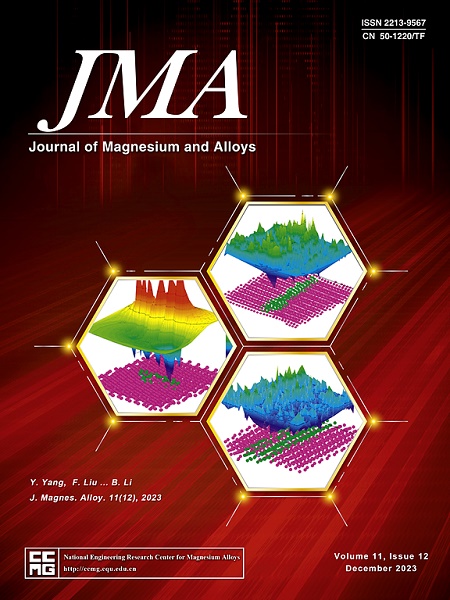通过纳米级准长周期堆叠有序单元与孪晶的相互作用实现高强韧性镁合金
IF 15.8
1区 材料科学
Q1 METALLURGY & METALLURGICAL ENGINEERING
引用次数: 0
摘要
具有高强度和良好延展性的镁合金因其高硬度、丰富的原材料和环境友好性,在交通运输、航空航天和生物植入物等领域的应用尤为理想。然而,包括晶粒细化和析出强化在内的大多数传统强化方法通常都会以牺牲延展性为代价来禁止位错运动。在此,我们报告了一种在室温下同时提高 Mg-0.2Zn-0.6Y (at.%) 合金屈服强度(205 兆帕,2.41 倍)和伸长率(23%,1.54 倍)的有效策略,其基础是通过超高压处理和退火形成纳米级准长周期堆叠阶单元(QLPSO)-孪晶结构。通过透射电子显微镜观察和分子动力学模拟,阐明了独特的 QLPSO 双结构的形成原因和强导机制。强度的提高主要与纳米级 QLPSO 的存在和修正的 ∠86.3o QLPSO 双边界(TB)界面有关,它们有效地抑制了位错运动。相对而言,延展性的增强与∠3.7o QLPSO-TB 界面和纳米级 QLPSO 的微扭结有关,它们为塑性变形提供了一些路径。这种 QLPSO 双胞结构策略可能为设计具有优异机械性能的创新型六方紧密堆积结构材料提供了另一种视角。本文章由计算机程序翻译,如有差异,请以英文原文为准。
High-strong-ductile magnesium alloys by interactions of nanoscale quasi-long period stacking order unit with twin
Magnesium alloys with high strength in combination of good ductility are especially desirable for applications in transportation, aerospace and bio-implants owing to their high stiffness, abundant raw materials, and environmental friendliness. However, the majority of traditional strengthening approaches including grain refining and precipitate strengthening can usually prohibit dislocation movement at the expense of ductility invariably. Herein, we report an effective strategy for simultaneously enhancing yield strength (205 MPa, 2.41 times) and elongation (23%, 1.54 times) in a Mg-0.2Zn-0.6Y (at.%) alloy at room temperature, based on the formation of a nanosized quasi-long period stacking order unit (QLPSO)-twin structure by ultrahigh-pressure treatment followed by annealing. The formation reason and strong-ductile mechanism of the unique QLPSO-twin structure have been clarified by transmission electron microscopy observations and molecule dynamics simulations. The improved strength is mainly associated with the presence of nanosized QLPSO and the modified ∠86.3o QLPSO-twin boundary (TB) interface, effectively pinning dislocation movement. Comparatively, the enhanced ductility is related to the ∠3.7o QLPSO-TB interface and micro-kinks of nanoscale QLPSO, providing some paths for plastic deformation. This strategy on the QLPSO-twin structure might provide an alternative perspective for designing innovative hexagonal close-packed structural materials with superior mechanical properties.
求助全文
通过发布文献求助,成功后即可免费获取论文全文。
去求助
来源期刊

Journal of Magnesium and Alloys
Engineering-Mechanics of Materials
CiteScore
20.20
自引率
14.80%
发文量
52
审稿时长
59 days
期刊介绍:
The Journal of Magnesium and Alloys serves as a global platform for both theoretical and experimental studies in magnesium science and engineering. It welcomes submissions investigating various scientific and engineering factors impacting the metallurgy, processing, microstructure, properties, and applications of magnesium and alloys. The journal covers all aspects of magnesium and alloy research, including raw materials, alloy casting, extrusion and deformation, corrosion and surface treatment, joining and machining, simulation and modeling, microstructure evolution and mechanical properties, new alloy development, magnesium-based composites, bio-materials and energy materials, applications, and recycling.
 求助内容:
求助内容: 应助结果提醒方式:
应助结果提醒方式:


